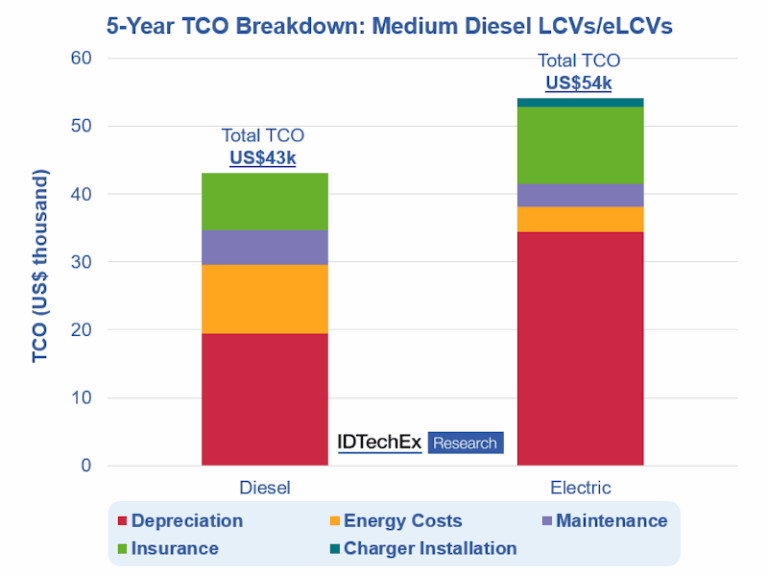The Rise of Electric Light Commercial Vehicles
With global cargo and e-commerce demand set to skyrocket over the next 20 years, electric light commercial vehicles (eLCVs) will play a crucial role in the decarbonization of transport. While eLCVs are now technologically mature enough to compete with combustion vehicles on virtually all performance metrics, they must still demonstrate financial competitiveness to be adopted en-masse into commercial fleets.

Current Challenges for eLCVs
The main financial benefits of eLCVs lie in their lower operating costs. Using electricity instead of diesel creates considerable savings over a vehicle’s lifetime and protects against volatile fluctuations in diesel prices. According to IDTechEx’s report, a standard eLCV can save as much as $1,300 per year on energy alone compared to a diesel alternative. eLCVs also require less maintenance than conventional combustion LCVs, resulting in lower costs and greater availability for fleets.
However, eLCVs struggle with higher upfront costs, primarily due to the cost of battery systems and drivetrains. The price premium of an eLCV varies by manufacturer, region, and size, ranging from 10-20% for smaller vehicles to 40-60% for larger ones. Depreciation is another significant challenge, as eLCVs face faster depreciation due to market hesitance and concerns around battery lifetime and maintenance.
The Changing Financial Landscape
Despite current challenges, eLCVs have the potential to achieve not just TCO parity with combustion LCVs but also CAPEX parity. Continuing development of battery technology is set to lower battery pack prices, reducing eLCV upfront costs. Improvements in drivetrain efficiency will enable the use of smaller batteries and less powerful motors, bringing costs down further. Growing demand and popularity of eLCVs will also lead to greater economies of scale, generating long-term savings.
Regulation is set to play a bigger role in TCO comparisons, with tightening emissions legislation and generous grants for eLCV purchases. Many countries offer grants between $3,000-10,000 to offset upfront costs. Local emissions restrictions, such as London’s Ultra Low Emissions Zone, will further shift the TCO balance in favor of eLCVs.
Future Outlook
IDTechEx’s report ‘Electric Light Commercial Vehicles 2025-2045: Markets, Players, Forecasts’ finds that universal TCO parity will rely on changing longer-term market dynamics. As eLCVs become more commonplace, customer perceptions around their performance, reliability, and battery lifetime will change, helping to shift resale values and decrease the impact of depreciation on TCO. With more eLCVs on the road, insurance premiums will also decrease, bringing them closer to those of diesel LCVs. The report predicts that over 11 million eLCVs will be sold annually by 2045, driven by improving technology and reducing costs.



